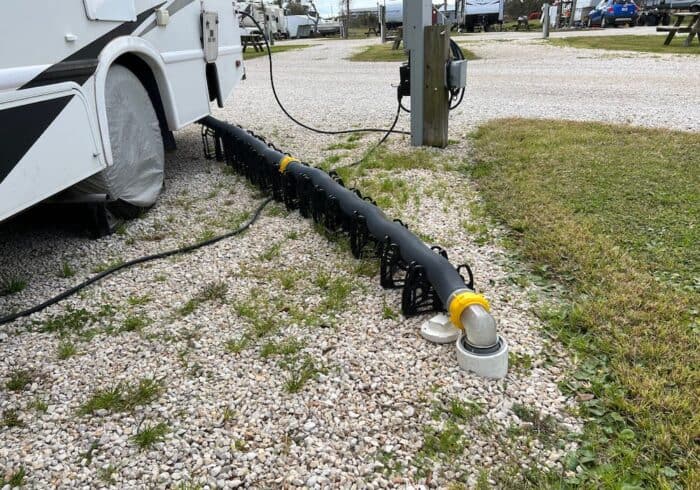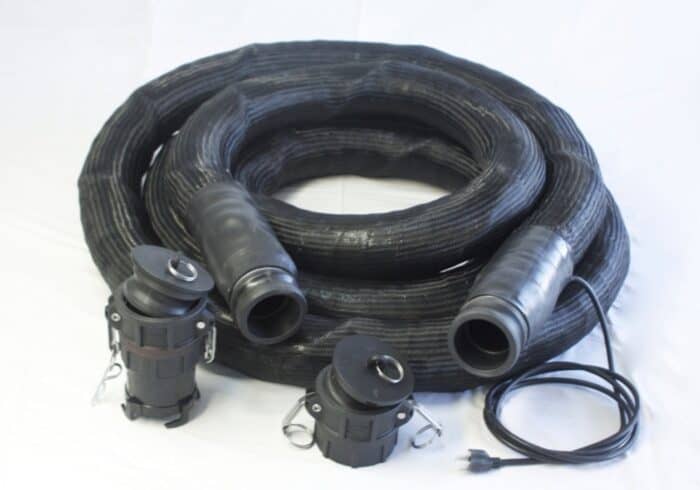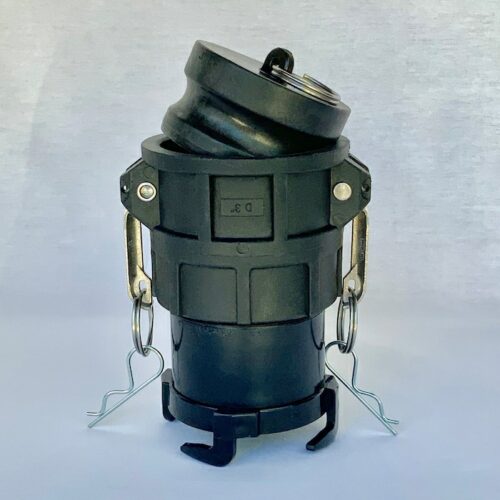Why Get a Heated RV Sewer Hose?
When temperatures drop, the first thing RVers unpack is a heated RV water hose.
The RV sewer hose is often forgotten, which can lead to messy problems when it’s time to empty the holding tanks.
Related Product: Complete your winter RV prep with a Camco Heated Drinking Water Hose (click to view on Amazon)
When compared to the water hose, an RV sewer hose doesn’t have the same high risk of freezing in cold weather.
The RV sewer hose should be empty most of the time because the black and grey tank valves should only be opened when dumping the RV.
So why get a heated RV sewer hose if it’s not something that usually freezes?
You may want to get a heated RV sewer hose to keep the gate valves and outlet pipe from freezing.
Cold weather RVs usually have heat pads on the bottom of the grey and black tanks, but the valves and outlet are often exposed.
Getting a heated RV sewer hose will help keep that area warm and in good condition. The last thing you want is a frozen seal or cracked gate valve.
The same goes for the sewer hose as well. Even when fully drained, there is usually some moisture inside the pipe.
Freezing temperatures can cause the walls of the sewer hose to get brittle and crack easily if moved.
A heated RV sewer hose is a tool that will mostly give you peace of mind if you live in an RV in freezing temperatures.
If you dump your RV into a frozen sewer hose, it could easily crack and leak.
No one wants to have to clean up raw sewage, especially when it’s freezing outside.
If you occasionally camp in cold weather, you probably don’t need to worry about getting a heated RV sewer hose.
But for full time RVers who live in cold temperatures, it’s something that will really help keep the RV sewage system running smoothly.
See Also: 6 Best Diesel Heaters For Campers, RVs & Vans
Best Heated RV Sewer Hose Reviews
H&G Lifestyles Heated RV Sewer Hose
H&G is one of the few companies out there making heated RV sewer hoses that are ready to go right out of the box.
They’ve combined thick insulation with an electric heat cable to create a compact RV sewer hose that is rated to work in temperatures as low as -20°F.
The front of the hose is fitted with a universal 3 inch bayonet fitting. It’s the same part you will find on any other RV sewer hose on the market today.
The hose is diameter is smaller than your standard RV sewer hose. Instead of being 3 inches in diameter, it’s only 2.
The smaller hose is used so there’s room for insulation but the overall size of the hose is manageable and easy to store.
If you have trouble dumping waste from the black tank through the smaller hose.
Add more black tank treatment and water to the tank so the solid waste breaks down faster and into smaller pieces.
See Also: Best Small Portable Propane Heater For Indoor & RV Use
The hose is covered with thick insulation, a heat cable, and a durable outer shell that’s weather and puncture resistant.
To protect against overheating, the heating cable regulates the temperature automatically.
It will heat more when it’s colder and less when it’s warmer.
Instead of a standard 4 in 1 threaded sewer connector, H&G uses a large rubber sealing ring on the end of the heated RV sewer hose.
The rubber ring insulates and protects the connection to the sewer and there’s a threaded fitting that fits around the sewer outlet for a secure connection.
There are 10, 15, and 20 foot options available.
If you don’t want to deal with the hassle of wrapping an RV sewer hose in heat cable and insulation yourself, or you want a compact and portable option, the H&G Lifestyles Heated RV Sewer Hose is a fantastic choice.
It’s built for travel, can withstand very cold temperatures, and it’s a great way to keep the valves and holding tanks from freezing.
PROS
- Insulated
- Protected Heat Cables
- Self Regulating Temperatures
- Universal Bayonet Fitting
- Protective Outer Sleeve
- Compact & Portable Size
CONS
- Small Drain Hose
- Sewer End My Not Fit Irregular Sewer Outlets
No Freeze Waste Hose
(Use code THECAMPINGNERD for 5% off your purchase)
Disclaimer: The link above is an affiliate link, which means that we earn a small percentage of your purchase. It does not cost any extra to you as a buyer to purchase via our link.
The No Freeze Water Hose is one of our favorite winter RV products. The same company also makes a heated RV waste hose.
Made with the highest standards and parts, the No Freeze Waste Hose is going to get you through cold winters anywhere.
The inside of the RV sewer hose is the same diameters as a standard one, 3 inches.
That means no drain space is given up for insulation and heating.
The outer diameter is 4 inches, so it’s still a manageable size and not too big to fit on a regular RV sewer hose stand.
See Also: How To Stay Warm In An RV At Night Without Using The Furnace
Wrapped around the 3 inch polyethylene waste hose is a powerful self regulating heat cable.
It’s programed to keep follow the outside temperatures to stop overheating and to keep the inner hose in working condition.
The maximum temperature the heat cable gets up to is 149°F (65°C). It’s rated for temperatures as low as -40°F (-40°C).
Around the heat cable is a fire resistant thermal insulation that’s made of industrial PVC foam.
The insulation stays flexible in frigid temperatures, doesn’t absorb moisture, and keeps out dust.
On the outside of the No Freeze heated RV sewer hose is a durable polyester monofilament woven cover that’s tear and water resistant.
There are 10, 15, 20, and 25 foot options available.
A 25 foot section will use around 1.5 amps of power depending on how cold it is.
Since the heating cable is self regulating, you never need to turn anything on/off and you don’t need to install a thermostat yourself.
No Freeze uses a special connection on the ends of its sewer hoses.
You will need to purchase an adapter kit (click to check price on website) to connect it to the RV and sewer outlet or make one yourself.
The adapter/conversion kit comes with a female bayonet adapter for connecting the hose to the RV.
There’s also a male bayonet adapter for connecting to the adapter you use for the sewer connection.
The No Freeze Waste Hose is the best heated RV sewer hose on the market today.
No Freeze makes a fantastic heated water hose that we highly recommend for winter camping and the waste hose is no different.
Click here to see full review of the No Freeze Heated Water Hose
They have amazing customer service and it’s a company you can rely on for high quality RV parts that work.
PROS
- -40°F Temp Rating
- High Quality PVC Insulation
- Protected Heat Cables
- Self Regulating Temperatures
- Protective Outer Sleeve
- Compact & Portable Size
- 3 Inch Drain Hose
CONS
- Must Purchase Adapter Kit to Connect to RV & Sewer
Alternative to Heated RV Sewer Hose
H&G Lifestyles Heated RV Sewer Hose Support
If you’re lucky enough to be RVing in an area where temperatures don’t go below freezing often or you don’t want to get a new sewer hose, the heated RV sewer support by H&G Lifestyles is another great option.
It’s recommended to put the RV sewer hose on a stand whenever you are hooked up to a sewer connection.
The stand makes it so the hose can drain fully, which is especially important in cold weather.
H&G Lifestyles has combined heat with a sturdy sewer hose stand.
There are 6 pieces in a pack that are 22 inches long each. When connected, they can hold up 15 feet of sewer hose.
It’s not as effective as the heated RV sewer hose reviewed above, but it’s still advertised to stop a sewer hose from freezing in temperatures as low as 10°F.
See Also: Best RV Antifreeze For Winterizing Your Camper Reviews
Each section has a heat plate. Each stand section is connected via waterproof plugs.
One section has a 10 foot power cord to supply electricity to all the sections.
Unlike the heated RV sewer hose that has a self regulating temperature control, the heated stand has one temperature, 140°F.
The stand sections are made of metal U shaped channels that are held up with metal tripods on each end.
There’s a little work involved when setting it up because the pieces need to be put together.
Once it’s set up, the stand is sturdy and a great choice for a sewer hose stand even in warm temperatures.
If you don’t want to get a new RV sewer hose, or you don’t live in an RV in super cold climates, the H&G Lifestyles Heated RV Sewer Hose Support is a great option.
It will help keep the hose in good condition when temperatures drop well below freezing and make sure nothing freezes on its way down to the sewer.
PROS
- Works with All Standard RV Sewer Hoses
- Heat & Stand Combined
- Sturdy
- Helps Hose Drain Completely
CONS
- Only One Temp Setting
- Not Super Portable
- Some Setup Required

Do It Yourself Heated RV Sewer Hose
While getting a heated RV sewer hose that’s ready to go out of the box can be nice, it’s also possible to make your own.
Good insulation is the first step to protecting an RV sewer hose from the cold.
Sometimes just insulation is enough to keep the hose protected through mild winters.
Frost King Foil Backed Fiberglass Pipe Wrap (click to view on Amazon) is a popular choice.
It has protective fiberglass insulation on one side and weather resistant foil backing on the other.
Wrap the RV sewer hose with the aluminum side out.
You will need some weatherproof tape or a sleeve to wrap around the insulation to cover the gaps from overlapping the insulation.
Duct tape works well but if you want to match the aluminum backing, you can also use aluminum foil tape (click to view on Amazon).
The aluminum tape is also a good idea if you put a heat cable inside the insulation.
See Also: Best Portable Electric Heated Blankets For Camping
If you live in an extra cold climate, add a heat cable to the insulation to actively warm the RV sewer hose.
I recommend getting a self regulating heating cable like this one by Heatit (click to view on Amazon).
It has a built-in thermostat and will start heating as soon as temperatures go below 37°F.
It’s technically made for pipes that are up to 2 inches in diameter.
Since RV sewer hoses are not filled with water, the heating capabilities should be enough to keep the hose from cracking or freezing when dumping.
Wrap the heat tape around the RV sewer hose before the insulation.
Frequently Asked Questions About Heated RV Sewer Hoses
How do I keep my RV sewer hose from freezing?
RV sewer hoses don’t freeze as easily as water hoses because they aren’t full of water all the time, but they can still freeze and crack in cold temperatures.
A cracked sewer hose can quickly become a nightmare when dumping your RV.
To help stop that from happening, there are a few things you can do to keep your RV sewer hose from freezing.
The most basic option is to remove the RV sewer hose after dumping your RV and put it somewhere in the RV where the temperatures don’t drop below freezing.
This option isn’t always the best since it requires setting up the hose every time you want to dump the RV and there’s not always a warm place to put a dirty sewer hose.
See Also: Are RV Electric Waste/Dump Valves Worth It? + Reviews & Info
It also can leave the gate valves and drain outlet exposed to cold air.
The second option is to wrap the hose in insulation so it’s not totally exposed.
This is a good option for climates where temperatures don’t go far below freezing.
For cold winter climates, you should either get a heated RV sewer hose like the one reviewed at the beginning of this article, or wrap your RV sewer hose in heat cable and insulation.
Properly preparing every part of your RV for below freezing temperatures is key to having a repair free winter.
How do I unfreeze my RV sewer hose?
If there was still some water or waste inside the RV sewer hose and temperatures dropped below freezing, you may find yourself with a dreaded “poop-cicle” blocking the sewer hose.
If you have a little time before you need to use the sewer hose, you can wrap it in heat cable and insulation to thaw the waste inside.
Some RVers disconnect the frozen hose and dump warm water inside to melt the ice.
The hot water option is a fast way to help thaw the sewer hose, but it could also lead to cracks from the extreme temperature change inside the hose.
If you have the time, heat tape is going to be the safest way to thaw a frozen RV sewer hose.
It’s also a good way to stop it from happening again.
One thing I recommend is to actually just replace the RV sewer hose if you can.
Nothing is worse than a cracked or compromised RV sewer hose.
The last thing you want is waste spilling out, especially if you are in an RV park or campground.
If the hose is totally blocked by ice, something could have already broken inside.
Replacing the frozen RV sewer hose with a heated RV sewer hose or one that you can wrap in heat cable and insulation is the best way to make sure you don’t get any leaks later on.
What do I do if the grey or black tank valve is frozen shut?
Even if your RV black tank and grey tanks have heat pads on them and you have a heated RV sewer hose, there’s still a risk for the valves to freeze shut in especially cold temperatures.
The most important thing to remember is the valve or plastic around the valve can easily crack if heated too quickly.
Do not dump hot water onto the valve.
A hairdryer is a good option in a pinch. Use the low heat setting to blow warm air on the outside of the valve and surrounding pipes.
If you have a little more time and resources, you can wrap a heat cable around the valve and pipe and give it a few hours to thaw.
You could also use heat lamps to slowly heat the area around the valve, but this option could take all day to work.
If you know temperatures are going to drop extremely low. Prepare by adding antifreeze to your black and grey tanks to stop the valves from freezing.
Have any more questions about heated RV sewer hoses? Leave a comment below.







